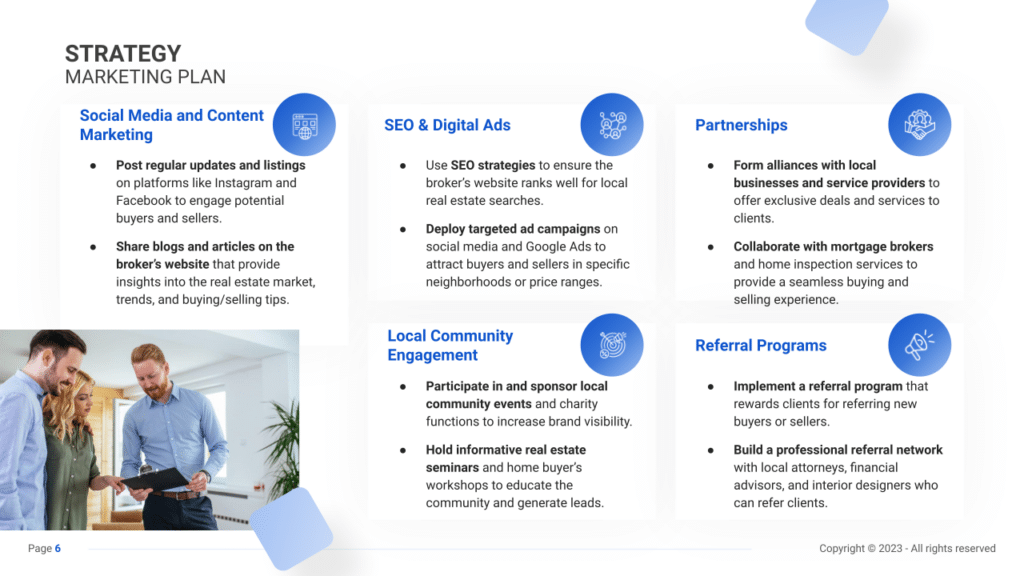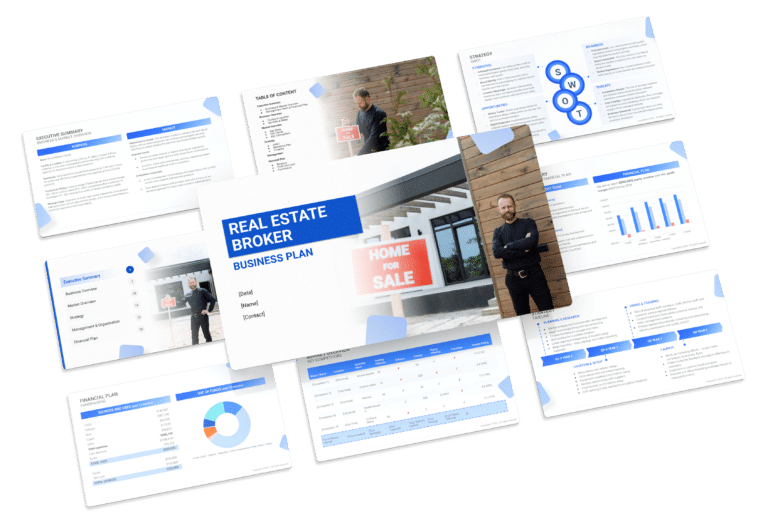Sales & Marketing Plan for a Real Estate Broker

Establishing a thriving real estate brokerage involves not only expertise in the field but also a strategic approach to marketing and sales. This comprehensive guide will help you prepare a sales and marketing plan tailored to the business plan of a real estate brokerage.
We’ll begin with a vital market analysis to understand competitors and client needs. Next, we cover building a strong brand identity and strategic positioning.
Following that, we’ll explore diverse marketing channels to connect with clients, and finally, delve into various sales strategies to boost revenue in the real estate industry. Let’s dive in!

Market Analysis
Understanding the real estate market is fundamental to devising successful marketing and sales strategies. This involves a meticulous analysis of market trends, competition, and customer needs.
Competitive Analysis
- Identify Competitors: Research other real estate brokerages in your area. Analyze their services, pricing models, client testimonials, and marketing initiatives to gain insights into their strengths and weaknesses. Consider aspects such as their target market, geographical coverage, and specialization in property types (residential, commercial, luxury).
- SWOT Analysis: Perform a SWOT analysis to assess your brokerage’s Strengths, Weaknesses, Opportunities, and Threats in comparison to competitors. This aids in recognizing areas for differentiation and improvement. Evaluate your team’s expertise, technological infrastructure, marketing strategies, and client satisfaction levels to identify competitive advantages and areas that require enhancement.
Target Audience Profiling
- Demographics & Preferences: Define the demographics (age, income, occupation) and preferences (property types, location) of your target clientele. Understanding their needs guides your marketing messaging and services. For instance, if targeting young professionals, emphasize convenience, modern amenities, and proximity to urban centers in your property listings and marketing content.
- Customer Expectations: Determine what your clients value the most in a real estate brokerage—whether it’s personalized service, expertise in specific property types, or a seamless transaction process. Conduct surveys or interviews with existing and potential clients to gather insights into their expectations and pain points when buying or selling properties.
Branding and Positioning
Crafting a strong brand image and defining your brokerage’s position in the market is pivotal for attracting clients and standing out amidst competition.
Brand Identity Development
- Brand Narrative and Values: Develop a captivating brand narrative that communicates the essence of your brokerage. Share the story behind your brokerage’s establishment. What drove you to enter the real estate market, and what principles or values guide your approach? Highlight your unique perspectives or philosophies that differentiate your brokerage in the industry.
- Visual Representation: Create a cohesive visual identity that encompasses your brand. Design a recognizable logo, select a distinctive color palette, and establish an interior design theme if applicable to your office space. Ensure these elements resonate with your target audience and reflect the professional personality of your brokerage.
Market Positioning Strategy
- Defining Your Unique Selling Proposition (USP): Identify and articulate what sets your brokerage apart from competitors. Is it your specialization in a particular niche market, your commitment to exceptional customer service, innovative marketing techniques, or your expertise in certain types of properties? Pinpoint the aspects that give your brokerage a competitive edge.
- Positioning Statement: Craft a concise positioning statement that encapsulates how you want your brokerage to be perceived by clients and stakeholders. This statement should reflect your USP and guide your marketing and operational decisions. It could convey your commitment to personalized service, your role as a market leader in a specific niche, or your dedication to transparency and integrity in real estate transactions.
Marketing Channels
To effectively reach potential clients and maintain a strong market presence, leveraging various marketing channels is crucial.
Digital Marketing
- Website & SEO: Develop a professional website showcasing property listings, client testimonials, and blog content relevant to real estate trends. Optimize it for SEO to rank higher in local property searches.
- Social Media: Utilize platforms like LinkedIn for professional networking, Facebook for community engagement, and Instagram for visually showcasing properties.
- Email Marketing: Build a mailing list and send regular newsletters with market updates, featured listings, and helpful real estate tips.
Local Advertising
- Collaborate with local publications for advertisements or featured articles about the real estate market in your area.
- Sponsor community events or neighborhood gatherings to increase visibility and establish connections within the community.
Partnerships & Networking
- Forge alliances with mortgage brokers, home inspectors, interior designers, and other professionals related to real estate. These partnerships can lead to referrals and mutual growth.
Promotional Activities
Engaging potential clients with attractive offers and initiatives can pique their interest and drive business.
- Exclusive Offers: Introduce special promotions like ‘Seller Incentive Packages’ or ‘First-Time Buyer Benefits’ to attract clients.
- Webinars & Workshops: Host educational sessions on home buying, investment properties, or market trends to position your brokerage as an authority.
- Referral Programs: Encourage existing clients to refer friends or family by offering incentives such as gift cards or discounts on future services.

Sales Channels
Utilizing effective sales channels ensures streamlined transactions and enhances customer satisfaction.
Client-Centric Service
- Personalized Approach: Tailor your services to meet individual client needs, whether they are looking to buy, sell, or invest.
- Transparency & Communication: Maintain open communication and provide transparent information throughout the buying or selling process.
Technology Integration
- CRM Systems: Implement customer relationship management tools to manage client data, interactions, and follow-ups efficiently.
- Virtual Tours & Technology: Utilize virtual reality, 3D tours, or high-quality images and videos to showcase properties effectively, especially for remote clients.
Networking & Follow-ups
- Networking Events: Attend industry conferences, seminars, or local real estate meetups to network and build relationships. Establish connections with other real estate professionals, potential clients, and industry influencers to expand your sphere of influence.
- Follow-up Strategies: Develop a systematic approach to follow up with leads and maintain contact with past clients to foster long-term relationships and potential referrals. Implement personalized follow-up emails, calls, or messages to stay engaged with clients even after the transaction is completed.





